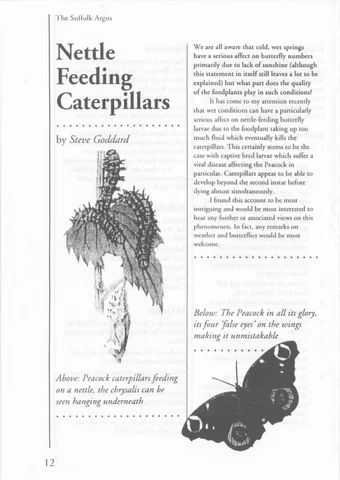The Suftulk Argus
Nettle Feeding Caterpillars by Steve Goddard
We are all aware that cold, wet springs have a serious affect on butterfly numbers primarily due to lack of sunshine (although this statement in itself still leaves a lot to be explained) but what pan does the quality of the foodplants play in such conditions? le has come to my attention recently that wet conditions can have a particularly serious affect on nettle-feeding butterfly larvae due to the foodplant taking up too much fluid which eventually kills the caterpillars. This certainly seems to be the case with captive bred larvae which suffer a viral disease affecting the Peacock in particular. Caterpillars appear to be able to develop beyond the second instar before dying almost simultaneously. I found this account to be most intriguing and would be most interested to hear any fimher or associated views on this phenomenen. In fact, any remarks on weather and butterflies would be most welcome.
Below: The Peacockin all its glory, itsfour 'falseeyes'on the wings making it unmistakable
Above: Peacockcaterpillarsfeeding on a nettle, the chrysaliscan be seen hanging underneath
12
the paths into seas of deep mud. But the Commas, Speckled Woods and White Admirals made the mud seem relatively insignificant. Ken Willmott knows every corner of the Common and exactly where to look for which bunerflies. He also has years of experience which he is willing to share. So we all learnt a loc. Did you know chat the female White Admirals flit from leaf to leaf, drumming on each with their shortened forelegs? As they do a chemical is released from the leaf which indicates to the butterfly whether it is a suitable honeysuckle leaf on which to lay an egg or the leaf of some other plant. Apparently, all female bucterflies identify the right plants for egg-laying in this way. Ken hunted round until he found and showed us some minute greeny-white eggs laid on the outer edges of honeysuckle leaves. We looked and marvelled - and wondered if we would ever have the skill to find any for ourselves. We saw many White Admirals and several Commas and Red Admirals. A sharp eyed observer found what was identified as a caterpillar of the Grear Prominent moth, plump green with yellow and red markings, very distinctive. However, the Purple Emperors were elusive. Ken assured us char as he has spent many lunch hours over many years srndying the Bookham Common lrntterflies he would show us exactly where co look, and when. He led us to a group of rail oak and turkc:y oak trees and said "Look 11pthere. "And suddenly there they were! Four big Purple Emperors contesting their territory high in the treetops. We caught an occasional purple flash as they whirled from shadow to sunlight. Marvellous! Heading back ro rhe car park for lunch we caught a glimpse of a Silver-washed Fricillary passing ar high speed. "Very rare for Bookham Common"said Ken. We paused ar an elm hedge and saw six White-letter
Hairstreaks, one close enough for the white leua marks on its underside co be clearly seen. There was evidence of the recurrence of Dutch Elm disease, which is very worrying. "Between /0 am a11dnoon the Purple Emperors come dow11 to this path to feast 011 the salts" said Ken. Bur by rhen it was I pm! But after lunch when most of us headed back IQ rhe area where we had seen the Emperors, we were mer by two exci1ed Suffolk Branch members. They had parked in different place and while 1hey lunched had seen a Purple Emperor come IQ the glQund near a scream and had been ahle IQ watch it for abour ten minutes. "/1 even uukd on my white blowe.'"How envious we all were, though delighted for our friend~. But during 1he next hour or so nearly everyone saw a Purple Emperor on the ground and were able IO take photographs, and s111dythis glorious bu11erfly carefully. The exceptions were the Kdseys, hack in the wood, gazing up at 1he undersides of two more Emperors up in the 1rees. Between us we saw eight Purple Emperors and were sure that the long journey south had been really worthwhile. The Suffolk Branch's first major outing gave us 17 varieties of woodland and grassland butterflies, and the unparalleled excitement of close-up views of one of Britain's rarest and most superb butterflies. We are extremely gra1eful to Ken Willmott for giving us some of his time and for sharing his knowledge with us. Please may we have many more guided outings?
5




